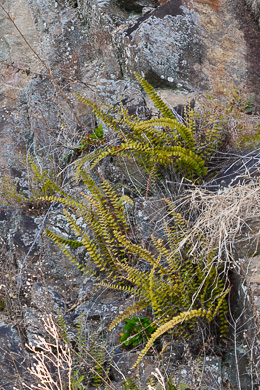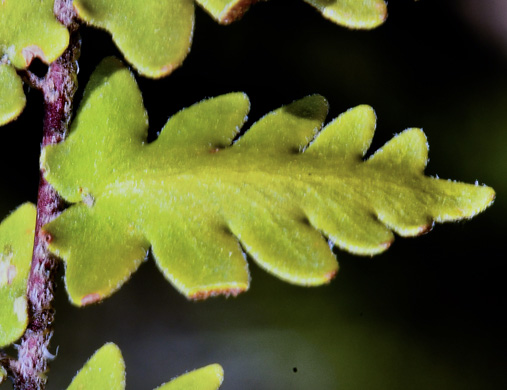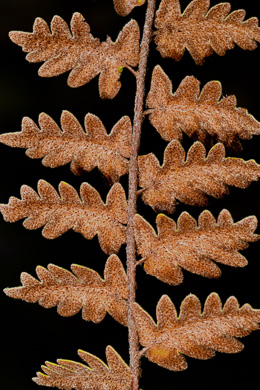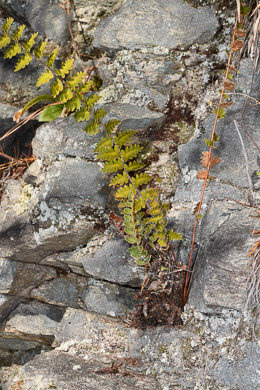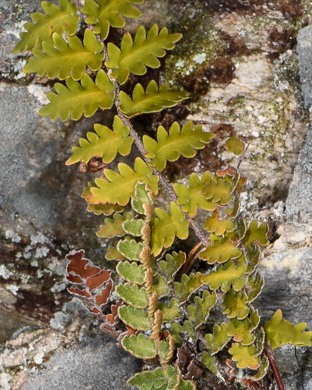Monilophytes (ferns): Leptosporangiate Ferns (true ferns): Polypodiales
WEAKLEY'S FLORA OF THE SOUTHEASTERN US (4/14/23):
Astrolepis sinuata ssp. sinuata
FAMILY
Pteridaceae
Go to FSUS key
Dig deeper at SERNEC, a consortium of southeastern herbaria.
Read more in Ferns and Lycophytes of Texas.
Read about the discovery of this fern in the Jocassee Gorges of South Carolina.
SYNONYMOUS WITH
PLANTS NATIONAL DATABASE:
Astrolepis sinuata ssp. sinuata
FAMILY
Pteridaceae
SYNONYMOUS WITH Floristic Synthesis of North America. BONAP (Kartesz, 2021)
Astrolepis sinuata ssp. sinuata
INCLUDED WITHIN The global flora: a practical guide to vascular plant species of the world (Christenhusz, Fay, & Byng, 2018)
Hemionitis sinuata
SYNONYMOUS WITH The Ferns and Lycophytes of Texas (Diggs & Lipscomb, 2014)
Astrolepis sinuata ssp. sinuata
SYNONYMOUS WITH Floristic Synthesis of North America (Kartesz, 1999)
Astrolepis sinuata ssp. sinuata
SYNONYMOUS WITH Flora of North America north of Mexico, vol. 2 (1993)
Astrolepis sinuata ssp. sinuata
SYNONYMOUS WITH Manual of the Vascular Plants of Texas (Correll & Johnston, 1970)
Notholaena sinuata var. sinuata
COMMON NAME:
Wavy Cloak Fern, Wavy Scaly Cloak Fern
To see larger pictures, click or hover over the thumbnails.
Ed Pivorun ebp_astrolepis_sinuata
December Pickens County SC
Jocassee Gorges
Some consider Astrolepis to be the most sun-tolerant of the xerophytic ferns, per The Ferns and Lycophytes of Texas (Diggs & Lipscomb, 2014).
Ed Pivorun ebp_astrolepis_sinuata2
December Pickens County SC
Jocassee Gorges
Pinnae alternate, oblong with short petioles, cut 1/3 to 1/2 way to midvein, per Field Guide to the Ferns and Other Pteridophytes of Georgia (Snyder & Bruce, 1986).
Ed Pivorun ebp_astrolepis_sinuata2b
December Pickens County SC
Jocassee Gorges
Longest pinnae 7-35mm long, deeply symmetrically lobed with 6-14 lobes, per The Ferns and Lycophytes of Texas (Diggs & Lipscomb, 2014).
Ed Pivorun ebp_astrolepis_sinuata3
December Pickens County SC
Jocassee Gorges
Lower surface covered w hairy scales. Sori continuous along reflexed margin, per Field Guide to the Ferns and Other Pteridophytes of Georgia (Snyder & Bruce, 1986).
WEAKLEY'S FLORA OF THE SOUTHEASTERN US (4/14/23):
Astrolepis sinuata ssp. sinuata
FAMILY
Pteridaceae
SYNONYMOUS WITH
PLANTS NATIONAL DATABASE:
Astrolepis sinuata ssp. sinuata
FAMILY
Pteridaceae
SYNONYMOUS WITH
Floristic Synthesis of North America. BONAP (Kartesz, 2021)
Astrolepis sinuata ssp. sinuata
INCLUDED WITHIN
The global flora: a practical guide to vascular plant species of the world (Christenhusz, Fay, & Byng, 2018)
Hemionitis sinuata
SYNONYMOUS WITH
The Ferns and Lycophytes of Texas (Diggs & Lipscomb, 2014)
Astrolepis sinuata ssp. sinuata
SYNONYMOUS WITH
Floristic Synthesis of North America (Kartesz, 1999)
Astrolepis sinuata ssp. sinuata
SYNONYMOUS WITH
Flora of North America north of Mexico, vol. 2
Astrolepis sinuata ssp. sinuata
SYNONYMOUS WITH
Manual of the Vascular Plants of Texas (Correll & Johnston, 1970)
Notholaena sinuata var. sinuata
If a search such as "Carex leptalea var. leptalea" doesn't deliver the results you want, try "Carex leptalea".
Or, to minimize chances of a misspelling, try just "Carex le".
Less is more: If "pencil flower" doesn't deliver the results you want, try "pencil".

